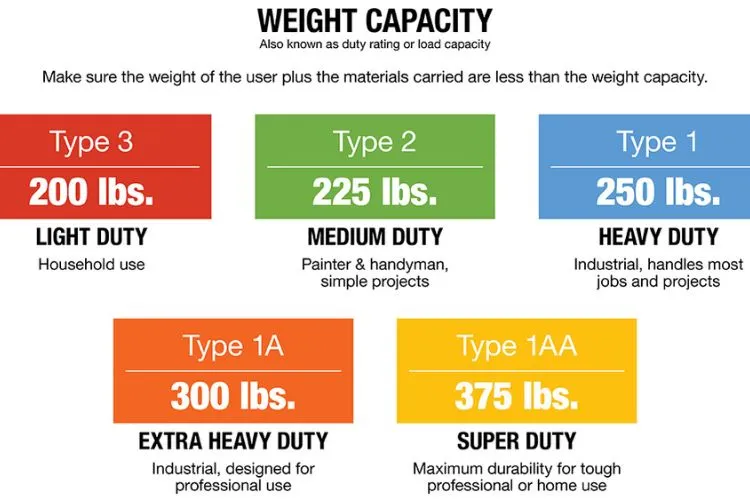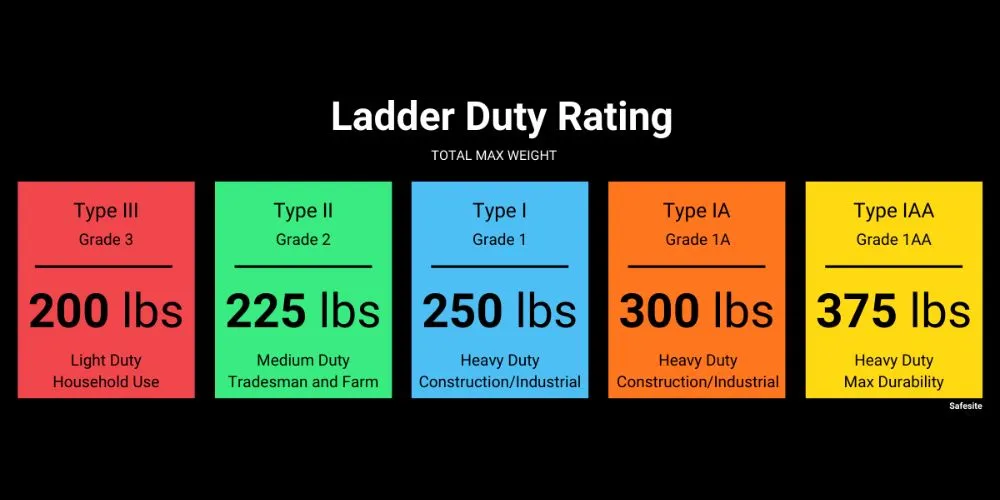When it comes to selecting a ladder, whether for home or professional use, safety should be the top priority. One key aspect of ensuring ladder safety is understanding ladder type ratings.
These ladder type ratings are not arbitrary; they serve as a guide to selecting a ladder that is suited for a particular job’s demands and that can carry the necessary weight.
The ladder type ratings, which take into account both the user’s weight and the weight of any items they might be carrying, are established by safety standards and are critical for preventing accidents and injuries.

Ladder type ratings exist to inform us about the maximum load capacity a ladder can safely handle and to indicate the most suitable environment for its use.
They are set by recognized safety organizations, such as the American National Standards Institute (ANSI) and the Occupational Safety and Health Administration (OSHA).
These ratings are crucial for choosing the right ladder; failing to do so can lead to dangerous, even fatal, consequences.
Understanding Ladder Type Ratings
Ladder type ratings are meant to be a reliable indicator of a ladder’s strength and stability. They tell us how much weight a ladder can support, considering not just the person climbing it, but also any tools or materials that they might take along.
This system helps match the ladder to the job and ensures that the ladder can handle the task without risking the safety of the user.
The ratings apply to both portable and fixed ladders and are categorized into types such as IA, I, II, and III. Each category corresponds to a different duty rating, which reflects the ladder’s maximum load capacity.
A ladder’s duty rating is typically marked on a label on the side of the ladder and is one of the first things you should check before making a purchase or beginning your work.
Importance of Ladder Type Ratings
Choosing a ladder that has an appropriate type rating for your job is essential for preventing accidents. A ladder that is too weak for a heavy task may break or collapse, causing serious injury.
Moreover, using the incorrect type of ladder can also wear it down faster, leading to premature failure and additional safety risks.
It is not only about the immediate risks either. Incorrect use of a ladder can affect its integrity over time, potentially leading to accidents even when lighter loads are applied later on.
Therefore, it is not only a matter of safety but also of economic sense to select the right type of ladder; it ensures a longer lifespan of the equipment and avoids the costs associated with ladder failure and accidents.
Key Categories of Ladder Type Ratings
The ladder type rating system is divided into several categories. Each is clearly defined to help users make informed choices about the ladder they need.

🪜Type IA Ladders
Type IA Ladders are built for the toughest jobs. They have a duty rating of up to 300 pounds, making them suitable for industrial settings or heavy construction work.
The materials used to make these ladders need to be as resilient as the tasks they’re meant for—typically materials like reinforced aluminum or heavy-duty fiberglass. People working in heavy construction, industrial jobs, or any tasks that require carrying lots of heavy tools can depend on Type IA ladders for stability and durability.
🪜Type I Ladders
For slightly lighter tasks that nonetheless require a sturdy ladder, Type I ratings apply. These ladders can support up to 250 pounds. Like Type IA ladders, they are often constructed with heavy-duty materials and are suitable for commercial and residential tasks that require robust support.
You might see these ladders being used in warehouses, on construction sites, and sometimes for heavier-duty tasks around the home.
🪜Type II Ladders
Type II Ladders cater to light commercial and residential duties. They have a load capacity of up to 225 pounds and are just right for occasional usage in office buildings or by homeowners.
The materials used in these ladders balance lightweight characteristics with adequate strength, often being more economical without sacrificing safety.
🪜Type III Ladders
At the lighter end of the spectrum, Type III Ladders are designed for loads up to 200 pounds. These ladders are best for those tasks you might take on around the house, such as changing light bulbs, reaching high shelves, or performing simple maintenance work.
They are often made from lighter aluminum or wood and are not intended for heavy or frequent use.
Selecting the Right Ladder for the Job
Selecting the right ladder is not just about choosing any ladder that can support your weight. You need to take into account the job’s demands and environment.
For example, using a metal ladder near electrical wires is not safe, regardless of the duty rating. This is where the material of the ladder becomes an important consideration.
Safety Tips for Using Ladders
Using a ladder safely extends beyond choosing the correct duty rating. Every use should start with inspecting the ladder for damages.
Regular checks ensure that wear and tear have not compromised the ladder’s structural integrity.
Maintenance and Storage
Maintaining the condition of your ladder is as important as selecting the right one. Proper maintenance according to the type rating ensures the ladder remains reliable and safe.
Similarly, storing the ladder in a proper manner preserves its lifespan and safety features.

Regulatory Compliance and Certification
Compliance with safety standards is not optional. ANSI and OSHA guidelines provide a basis for evaluating ladder safety and should be the primary reference for any ladder manufacturer or user.
Certification implies that a ladder has been tested to meet specific safety requirements, which can give users confidence in their equipment.
Frequently Asked Questions (FAQs)
What are ladder type ratings?
Ladder type ratings categorize ladders based on their maximum load capacity, including the weight of the user plus any materials being carried, to ensure safety and durability.
How many types of ladder ratings are there?
There are five main types: Type IAA, Type IA, Type I, Type II, and Type III, each designed for different weights and usage conditions.
What does a Type I ladder rating signify?
A Type I ladder is rated for heavy-duty industrial use, supporting up to 250 pounds.
Can I use a Type III ladder for construction work?
No, Type III ladders are for light-duty usage, such as household tasks, and can only support up to 200 pounds.
How do I know which ladder rating I need?
Consider the total weight of the user plus any tools or materials to be carried on the ladder, and select a rating that exceeds this total weight for safety.
Conclusion:
Understanding ladder type ratings is vital for every user. It’s about safety, longevity of the ladder, and peace of mind. With the correct knowledge, you can make an informed choice and conduct your work with the assurance that you are using the equipment as intended.


